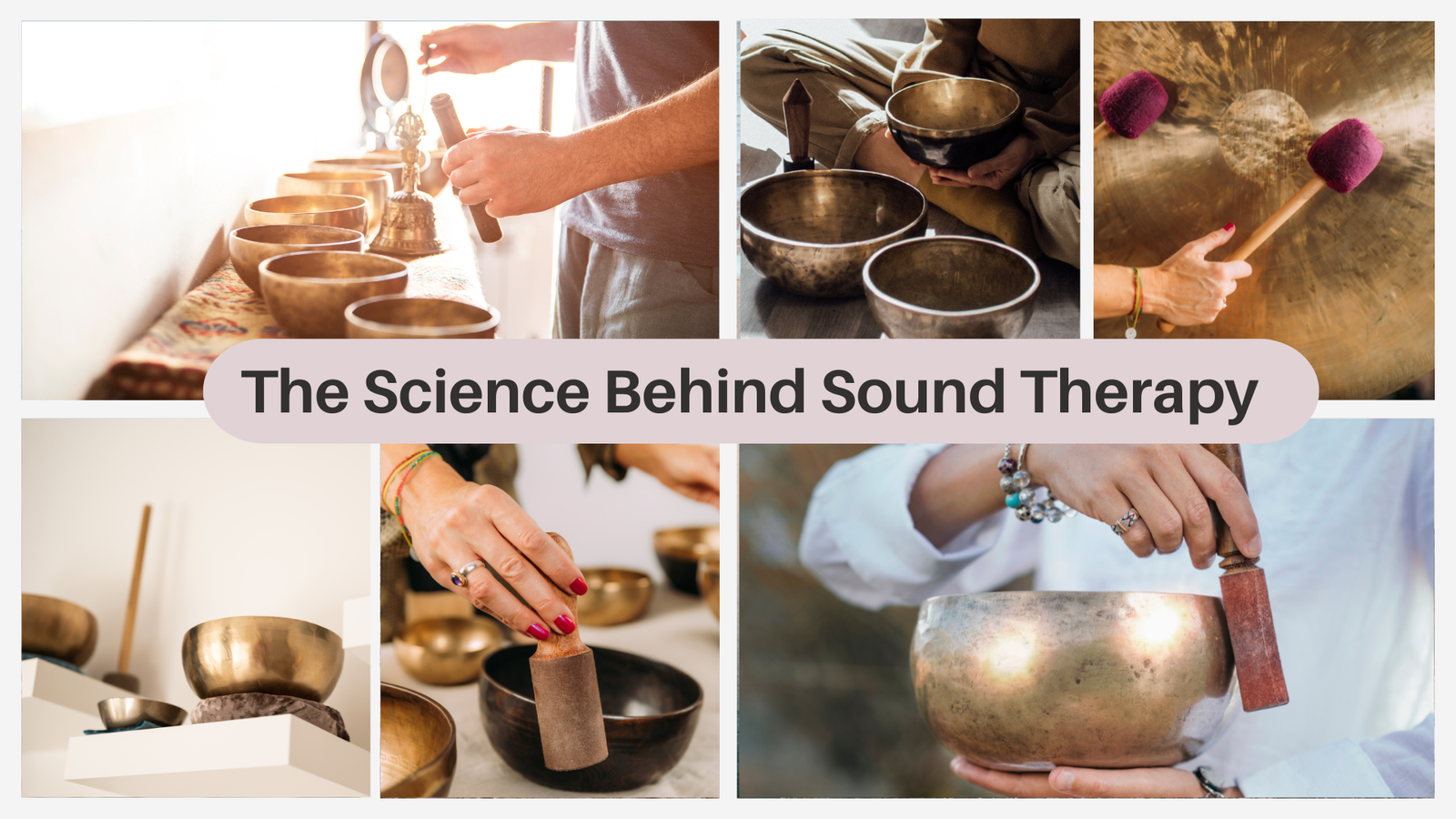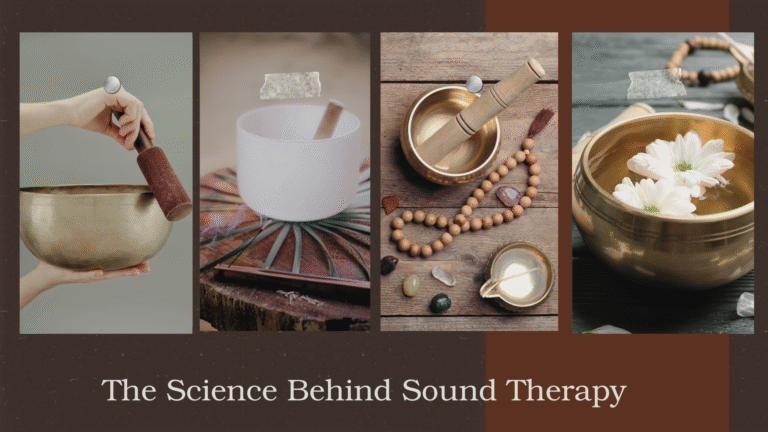The Science Behind Sound Therapy explores how sound vibrations influence the mind, body, and spirit. This therapy uses instruments like Tibetan singing bowls, gongs, and tuning forks to promote relaxation, reduce stress, and enhance mental clarity. The science behind sound therapy explains how specific frequencies can balance energy, improve brainwave patterns, and support emotional healing.
Integrating meditation and holistic techniques, it helps restore harmony within the body while boosting overall well-being. With both experiential and research-backed benefits, the science behind sound therapy is recognized as a powerful tool for physical, emotional, and spiritual health, making it increasingly popular worldwide.

Understanding Sound Therapy: Ancient Wisdom Meets Modern Science
Sound therapy has gained global recognition as a powerful approach to achieving mental, emotional, and physical balance. Rooted in centuries-old traditions, this practice uses specific vibrations and frequencies to influence the human body and mind. Ancient cultures, from India to Tibet, employed chanting, gongs, and singing bowls to promote relaxation, spiritual growth, and healing. These practices form the foundation of modern sound healing, which integrates traditional wisdom with contemporary wellness techniques.
Today, practitioners combine carefully calibrated instruments with mindfulness, meditation, and energy work to restore harmony and vitality. Holistic healing through sound is valued not only for stress reduction but also for improving focus, boosting immunity, and enhancing emotional resilience. Scientific studies have begun to explore the measurable effects of sound waves on brain activity, nervous system regulation, and energy fields, supporting the mechanisms of sound therapy observed for centuries.
The physics of sound healing explains how resonance and vibration interact with cells, tissues, and neural pathways, creating a profound sense of relaxation and balance. By understanding the science of sound healing, individuals can appreciate how ancient methods and modern research converge, offering a natural path to wellness. Whether used in personal meditation, therapeutic sessions, or group sound baths, this practice demonstrates that the wisdom of the past, when combined with scientific insight, can transform health and consciousness, making sound therapy a valuable tool for contemporary holistic living.
How the Science Behind Sound Therapy Enhances Mind, Body, and Energy Wellness
The science behind sound therapy offers a profound way to restore balance and harmony within the mind, body, and energy systems. By using carefully structured sound frequencies, individuals experience relaxation, emotional release, and mental clarity. Over centuries, sound has been recognized as a tool for healing, influencing both physiological and psychological states. Modern practices integrate traditional approaches with scientific understanding to provide measurable benefits for overall wellness.
Sound healing techniques focus on the interaction between sound waves and the body’s natural vibrations. Instruments such as singing bowls, gongs, and tuning forks create resonance that can reduce stress, regulate the nervous system, and enhance focus. Vibrational healing therapy works on subtle energy fields, aligning chakras and promoting a sense of internal harmony. These methods allow the body to reset, supporting emotional balance, mental clarity, and physical rejuvenation.
In addition to personal sessions, sound therapy can be incorporated into meditation, group sound baths, and holistic wellness programs. Scientific studies now demonstrate that sound vibrations can influence brainwave patterns, encourage deep relaxation, and boost immune function. By understanding the mechanisms behind these effects, practitioners and participants alike can appreciate the tangible benefits of this ancient yet modern approach. Ultimately, the science behind sound therapy serves as a bridge between tradition and innovation, offering a natural, non-invasive path to enhancing mind, body, and energy wellness for individuals seeking holistic health solutions.
Ancient Practices of Sound Healing Across Cultures for Stress Relief and Energy Balance
Ancient sound healing has been practiced across various cultures for centuries, offering powerful tools for stress relief and energy balance. From India to Tibet and beyond, these traditions relied on the use of chanting, mantras, Tibetan singing bowls, and gongs to influence the mind, body, and spirit. The vibrations produced by these instruments are believed to harmonize energy centers, restore equilibrium, and promote emotional well-being.
Chanting and mantras were central to many ancient rituals, creating resonant frequencies that calmed the nervous system and enhanced mental clarity. Tibetan singing bowls and gongs, with their deep, rich tones, were used in meditation sessions and spiritual ceremonies to induce a state of relaxation and heightened awareness. These sounds helped practitioners connect with their inner selves, reduce anxiety, and release accumulated stress, supporting both mental and physical wellness.
Sound also played a vital role in meditation, enabling individuals to focus attention, regulate breath, and achieve mindfulness. In spiritual rituals, these practices symbolized purification, alignment, and the restoration of energy flow within the body. Modern research now supports many of these ancient observations, showing that sound vibrations can influence brainwave patterns, reduce stress hormones, and promote emotional balance.
By integrating chanting, Tibetan singing bowls, and gongs into daily practice, individuals can tap into the wisdom of ancient sound healing. These practices not only support meditation and mental wellness but also provide a holistic approach to stress relief and energy alignment, bridging cultural tradition with contemporary well-being practices.
Tools That Transform Sound into Healing Energy for Holistic Healing
Holistic healing with sound is an ancient practice that uses specific instruments and techniques to promote physical, emotional, and spiritual well-being. Tools such as Tibetan singing bowls, gongs, crystal bowls, chimes, and tuning forks are designed to produce vibrations that resonate with the body’s natural frequencies, restoring balance and energy flow. These instruments help release tension, reduce stress, and enhance overall wellness.
Meditation and sound therapy often go hand in hand, as the calming sounds of these instruments guide the mind into deeper states of focus and relaxation. During meditation sessions, practitioners use sound to enhance mindfulness, improve concentration, and create a harmonious environment that encourages emotional release and mental clarity. The combination of intentional listening and vibrational energy helps participants achieve a sense of inner peace and connectedness.
Chakra balancing with sound is another key aspect of holistic sound healing. Each chakra responds to specific frequencies, and instruments like singing bowls or tuning forks are used to align and harmonize these energy centers. By addressing imbalances, sound therapy supports vitality, emotional resilience, and spiritual growth.
Through these tools and techniques, sound therapy transforms vibrations into healing energy, providing a natural, non-invasive approach to health. Integrating meditation, chakra balancing, and sound instruments offers a holistic pathway to wellness, helping individuals reduce stress, enhance energy, and achieve balance in mind, body, and spirit.
The Role of Modern Applications of Sound Therapy in Contemporary Healthcare
Modern applications of sound therapy are increasingly recognized in contemporary healthcare for their ability to enhance mental, emotional, and physical well-being. Hospitals, wellness centers, and therapy clinics now incorporate sound healing practices to reduce stress, improve sleep, and support rehabilitation. Techniques such as sound baths, guided meditation with instruments, and vibrational therapy are used alongside conventional treatments to provide a holistic approach to patient care.
The Physiology of Sound Therapy explains how specific frequencies and vibrations interact with the body’s cells, tissues, and nervous system. Sound waves can influence brainwave patterns, regulate the autonomic nervous system, and stimulate the body’s natural relaxation response. By affecting heart rate, blood pressure, and hormone levels, sound therapy contributes to physiological balance and promotes overall wellness.
Sound Therapy Techniques and Science include the use of Tibetan singing bowls, gongs, tuning forks, and crystal bowls to produce targeted vibrations. These instruments are applied in both individual and group sessions to harmonize energy, support meditation, and alleviate tension. Scientific studies are beginning to quantify these effects, showing measurable benefits in mood regulation, pain management, and cognitive function.
Evidence-Based Sound Healing highlights research confirming the effectiveness of these techniques in reducing anxiety, enhancing mindfulness, and promoting emotional resilience. By combining ancient wisdom with modern scientific validation, sound therapy provides a non-invasive, complementary method for improving health outcomes, making it a valuable tool in contemporary healthcare and holistic wellness practices.
Embracing the Science and Art of Sound Therapy for Mind and Body Balance
Embracing the science and art of sound therapy offers a unique path to achieving mind and body balance. By combining ancient practices with modern research, sound therapy has emerged as a powerful tool for holistic wellness. The science of audio healing demonstrates how specific frequencies and vibrations can influence brainwave patterns, nervous system function, and emotional states, promoting relaxation and mental clarity.
The science of sound healing explains how instruments such as Tibetan singing bowls, gongs, and tuning forks create resonance within the body, aligning energy centers and reducing stress. Holistic healing with sound integrates these techniques with meditation, mindful breathing, and energy balancing to provide comprehensive physical, mental, and spiritual benefits. By understanding the science behind sound therapy, individuals can appreciate how vibrational energy interacts with cells, tissues, and subtle energy fields, supporting overall well-being.
The science behind vibrational therapy shows that sound waves not only soothe the mind but also stimulate physiological responses that aid healing, improve focus, and enhance emotional resilience. Modern practitioners utilize sound baths, guided sessions, and therapeutic instruments to create environments conducive to deep relaxation and self-awareness.
By embracing these methods, individuals can experience profound benefits for mind, body, and energy alignment. Integrating the science and art of sound therapy into daily life encourages a balanced, harmonious state, bridging the gap between ancient wisdom and contemporary wellness, and offering a non-invasive approach to enhancing overall health and emotional well-being.
FAQs
1. What is sound therapy?
Sound therapy is a healing practice that uses vibrations and frequencies from instruments or voice to improve mental, emotional, and physical well-being.
2. How does sound therapy benefit the mind and body?
It reduces stress, balances energy, enhances focus, improves sleep, and promotes emotional and physical relaxation.
3. Which instruments are commonly used in sound therapy?
Tibetan singing bowls, gongs, tuning forks, chimes, and crystal bowls are widely used.
4. Can sound therapy help with meditation and mindfulness?
Yes, sound therapy supports meditation by calming the mind, guiding focus, and creating a peaceful environment.
5. Is sound therapy scientifically proven?
Research shows that sound therapy can influence brainwaves, reduce stress hormones, improve mood, and support holistic healing.
Table of Contents
Related Content – Best Sound Healing Therapy Instruments
Content Writing—Digital Entire—Digital Marketing Company

